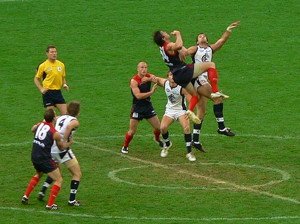Aussie Rules Football Rules

Aussie Rules has been around since 1841 in some form or another. Its game that is pretty much exclusively played in Australia and the only professional league of its kind, the Australian Football League (AFL) is also situated there. Many players affectionate with the sport may call it a mix of footy, football, Aussie rules and Australian rules.
Object of the Game
The object of the game is to kick the football between a series of 4 goal posts. Depending on which posts the ball goes between will depend on how many points you score. The ball can be passed around between team mates in a series of fashions and the winning team will be the team with the highest number of points at the end of the game.
Players & Equipment
Aussie rules pitches are usually played on oval sized pitches with dimensions ranging from 135 to 185 metres in length, and 110 to 155 metres in width. Many Aussie Rules pitches mix with cricket fields as they or of a similar size and proportion.
The pitches are marked around the outside to highlight the out of bounds area. At either end of the pitch 4 tall posts will be apparent. These are the scoring zones and are roughly 6 metres in height. The two front posts are 6.4 metres apart and represent the main scoring area (goal). The two post behind are also 6.4 metres apart and represent the secondary scoring area (point).
The ball is made from leather and forms an oval shape (similar to a rugby ball). Other markings on the pitch include a goal square that is 9 metres wide and spanning with width of the goals posts, centre square and centre circle.
Each team will consist of 18 players of which are all assigned to different positions. These players are allowed to move freely on the pitch. Each team may also have up to three substitutes which are ‘rolling’ meaning they can come on and off as many times as they want. Once a starting player gets substituted these players then become rolling. The positions are broken down into Full Forward, Half Forward, Centre Line, Half Back and Full Back.
There are 7 umpires for Aussie Rules in total. The three main umpires are known as filed umpires and they basically oversee all the decisions on filed such as time keeping, infringements and enforcing the rules. The two line judges are there to see if the ball goes out of play or not – these judges can also intervene where on filed umpires have missed a decision. The last two umpires are goal umpires and its their job to signal if a goal has been scored successfully or not.
Scoring
If the ball is kicked between the two goal posts (middle posts) then 6 points are awarded. If the ball goes between a goal post and one of the behind posts (point) then 1 point is awarded. 1 point is also awarded if the ball is carried or forced over the scoring line by the attacking team.
Winning the Game
The team with the highest amount of points at the end of the game are deemed the winners.
Rules of Aussie Rules Football
- Umpires signal for all decisions and their call is final
- By kicking the ball between the goal posts without it being touched by any other player, then 6 points are awarded. If the ball is kicked without being touched between the behind posts (point) then 1 point is scored.
- A game consist of four 20 minute quarters.
- The game starts with ruck. This is where the umpire throws the ball into the air and one player from each team will try and tap the ball to their team. After a goal has been scored the game will be restarted with the same way as at the beginning of the game.
- The only way you can pass the ball is to hand ball. For this to happen the ball must be placed in the palm of the hand and then the ball struck with the butt of the other hand clenched into a fist. You cannot throw or slap the ball to perform a successful pass.
- A player can ‘mark’ the ball when they receive it. This can happen one of three ways; the player catches the ball without the ball bouncing, the player catches the ball after it has travelled over 10 metres or the player catches the ball before it’s been touched in the air. Once marked the player cannot then be tackled. If a tackle occurs or an opponent steps over the mark then a foul will be called and the team with the ball will advance 15 metres down the field.
- Players can tackle opponents to try and win back the ball. A player can only be tackled from shoulder height downwards.
- If a player is tackled and refuses to let go of the ball then holding the ball will be called by the umpire and possession will be turned over.
- Players are permitted to block their opposition by shepherding players away from the ball. This can only be done within 5 metres of the ball.
- Players are omitted from pushing their opponents in the back either whilst they are running or whilst in a tackle.